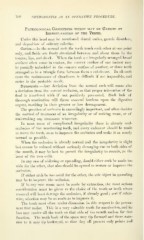Page 702 - My FlipBook
P. 702
700 ORTHODONTIA AS AN OPERATIVE PROCEDURE.
Pathological Conditions which may be Caused by
Irregularities of the Teeth.
Under this head may be mentioned dental caries, gastric disorders,
and deposition of salivary calculns.
Caries.—In the normal arch the teeth tonch each other at one point
only, and fluids are freely circulated between and about them by the
tongue, lips, and cheek. When the teeth are irregularly arranged broad
surfoces often come in contact, the convex surface of one incisor may
be partially imbedded in the concave surface of another, or three teeth
arranged as in a triangle form between them a cul-de-sac. In all such
cases the maintenance of cleanliness is difficult if not impossible, and
caries is the probable result.
Dyspepsia.—Any deviation from the normal arch will cause also
a deviation from the normal occlusion, so that proper trituration of the
food is interfered with if not positively prevented. Such lack of
thorough mastication will throw unusual burdens upon the digestive
organs, resulting in their greater or less derangement.
The question of occlusion is exceedingly important, and often decides
the method of treatment of an irregularity or of making room, or of
undertaking any treatment whatever.
In most cases of complicated irregularity there is already mal-
occlusion of the masticating teeth, and every endeavor should be made
to move the teeth, so as to improve the occlusion and make it as nearly
normal as possible.
When the occlusion is already normal and the irregularity is slight
but cannot be reduced without seriously deranging one or both sides of
the mouth, it may be best to permit the irregularity to remain, as the
least of the two evils.
In any case of widening or spreading, should either arch be made too
wide for the other, that also should be spread to restore or imi)rove the
occlusion.
If either arch be too small for the other, the sole object in spreading
may be to improve the occlusion.
If in any case room must be made by extraction, the most serious
consideration must be given to the choice of the tooth or teeth whose
removal will least derange the occlusion, if already good ; and if other-
wise, selection may be so made as to improve it.
The tooth most often under discussion in this respect is the perma-
nent first molar. This is a very valuable tooth for mastication, and its
loss may render all the teeth on that side of the mouth useless for that
function. The teeth back of the space may tip forward and those ante-
rior to it may tip backward, so that they all present only points and


